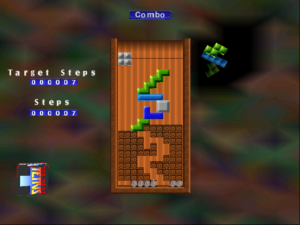The Next Tetris
 What an terrible title! Not only is it far from distinctive — a completely different Tetris variant called The New Tetris was released around the same time — it’s also quite arrogant. Or at least it is if you interpret it as “The thing that will be as significant to game culture as Tetris was”, as in “Every game designer hopes that their creation will be the next Tetris“. If you interpret it as “One more Tetris among many”, it’s a bit less so. Under that view, it even implies that the gameplay is so generic that they couldn’t come up with a descriptive title. Which isn’t really true: The Next Tetris delivered some genuine innovation within the Tetris format, subsequently reused in other titles. Instead of making every block completely static once it’s finished falling, staying with its row even when isolated and unsupported, TNT makes blocks only stick together if they’re the same color and fall otherwise. Delete a row, and bits of the row above have the potential to fill in gaps in the row below, potentially making Bejewelled-like cascades. To promote this kind of behavior, the designers decided to make two-color pieces that have the potential to split apart immediately on placement, if placed right.
What an terrible title! Not only is it far from distinctive — a completely different Tetris variant called The New Tetris was released around the same time — it’s also quite arrogant. Or at least it is if you interpret it as “The thing that will be as significant to game culture as Tetris was”, as in “Every game designer hopes that their creation will be the next Tetris“. If you interpret it as “One more Tetris among many”, it’s a bit less so. Under that view, it even implies that the gameplay is so generic that they couldn’t come up with a descriptive title. Which isn’t really true: The Next Tetris delivered some genuine innovation within the Tetris format, subsequently reused in other titles. Instead of making every block completely static once it’s finished falling, staying with its row even when isolated and unsupported, TNT makes blocks only stick together if they’re the same color and fall otherwise. Delete a row, and bits of the row above have the potential to fill in gaps in the row below, potentially making Bejewelled-like cascades. To promote this kind of behavior, the designers decided to make two-color pieces that have the potential to split apart immediately on placement, if placed right.
Doesn’t this all make it easier? Well, yes. Yes it does. Even ignoring the potential for cascades, the frangibility of the pieces means that you don’t need to spend so much time waiting for the straight piece to come up. The designers compensate for the increased ease with horrible, horrible time limits.
But that’s not what I want to talk about. The main game here is, for me, a sideline. The real reason I picked this game up is that I learned Scott Kim was involved in its creation. Although he’s probably still best-known for his invertable calligraphy, Kim is also an accomplished puzzlesmith with about a dozen games under his belt. Among them is Obsidian, which provided me with one of the most beautifully transcendent moments of realization I’ve experienced in a lifetime of gaming. 1Figuring out the override for the non-regulation flight, in case you’ve played it and were wondering. This memory was still fresh in my mind when TNT came out.
Kim’s specific contribution to TNT is a series of puzzle levels — yes, real puzzles, with designed solutions which you can discover by thinking about them, rather than the random configurations and speed play of normal Tetris and most other so-called “puzzle” games. In each, you’re given a fixed initial board and a fixed sequence of pieces, and you have a figure out how to delete the initial “garbage” in the minimum number of moves. (If you exceed par, the game lets you keep playing, but you know you’ve failed.) Some of them seem to be just a matter of trying different configurations until one works, but the better ones have some gimmick, some underlying principle that makes the whole thing easy when you think of it. For example, in the screenshot included here, the trick is to make the blocks into an inverted copy of the empty space, so that everything just cascades into place when the final piece unlocks the whole structure.
The puzzle levels are not a large part of the game, or one that it draws a great deal of attention to. I suspect that there are people who have played TNT a great deal who don’t even know they exist, just as I ignore multiplayer mode on most games. They’re listed under the main menu as “Practice Mode”, which is a lie: practicing the main game by playing these levels would be like practicing swimming by taking a long shower. It involves the same elements, but applied in a different way. Normal Tetris doesn’t allow you to replay the same situation over and over until you get it right, and that makes a huge difference. So does the certain knowledge that there is, in fact, a solution. You can’t blame the random number generator for your problems. No, you’d have to blame Scott Kim.
There are 19 practice mode levels. In my last session, I solved all but one, although not in order. If it takes me more than one more session to figure out the last, I will be sad.
| ↑1 | Figuring out the override for the non-regulation flight, in case you’ve played it and were wondering. |
|---|
 Comments(2)
Comments(2)
have you got a solution for “zipper”, no 19, yet?
I have not.